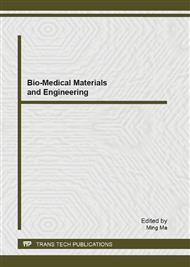[1]
Bidard F., Bony M., Blondin B., et al. Yeast. Vol. 1(2009), pp.809-822.
Google Scholar
[2]
Bony M., Thines-Sempoux D., Barre P., Blondin B. Bacteriol. Vol. 179(1997), p.4929–4936.
DOI: 10.1128/jb.179.15.4929-4936.1997
Google Scholar
[3]
Xu, T. J., Zhao, X.Q., Bai F.W. Enzyme and Microbial Technology. Vol. 37(2005), pp.634-640.
Google Scholar
[4]
Giovanna S., Patrizia R., Carlo Z. Canadian Journal of Microbiology. Vol. 30(1984), pp.36-39.
Google Scholar
[5]
Verstrepen K. J., Derdelinckx G., et al. Appl Microbiol Biotechnol. Vol. 61(2003), pp.197-205.
Google Scholar
[6]
Kedong M., Inato W., Kenji S., et al. Afr. J. Biotechnol. Vol. 9(2010), pp.1037-1045.
Google Scholar
[7]
Stratford M. Adv Microbiol Physiol. Vol. 33(1992), pp.2-71.
Google Scholar
[8]
Pauporté Thierry, Lincot Daniel. Electrochimica Acta. Vol. 45(2000), p.3345~3353.
Google Scholar
[9]
Goldstein A. N., Echer C. M., et al. Science. Vol. 256 (1992), pp.1425-1427.
Google Scholar
[10]
V. L. Colvin,M. C. Schlamp,A. P. Alivisatos. Nature. Vol. 370(1994), pp.354-357.
Google Scholar
[11]
Zhuo, R. F., Qiao, L., Feng, H. T., et al. Appl. Phycol. Vol. 104(2008):, pp.094101-5.
Google Scholar
[12]
Wang, H., Xie, et al. Hazard. Mater. Vol. 141(2007), p.645–652.
Google Scholar
[13]
Wo, C.M., Li, Y.H., Liu, Y.S., et a1. Journal of Applied Physics. Vol83(1998), pp.4389-4391.
Google Scholar
[14]
K. H. Tam, A. B. Djurišić, C. M. N. Chan, et al. Thin Solid Films. Vol. 516 (2007), p.6167~6174.
Google Scholar
[15]
Wang, D., He, J., Nista Rosenzweig, Zeev Rosenzweig. Nano Letters. Vol. 4 (2004), p.409–413.
Google Scholar
[16]
C. Allen, D. Maysinger, et al. Colloids and Surfaces B: Biointerfaces, Vol. 16(1999), p.3–27.
Google Scholar
[17]
Zhang, Y., Zhang, Y., et al. Journal of Electroanalytical Chemistry, Vol. 627(2009) , p.9–14.
Google Scholar
[18]
Lei, C. X., Hu, S. Q., Shen, G. L., Yu, R. Q. Talanta,. Vol. 59(2003), p.981–988.
Google Scholar
[19]
Ren, Y. H., et al. BMC Biotechnology. Vol. 11(2011), p.63.
Google Scholar
[20]
Ni, K. F., Lu, H. M., et al. Biotechnology and Bioengineering. Vol. 109(2012), p.2970–2977.
Google Scholar


